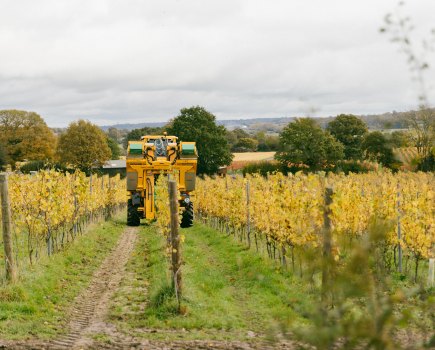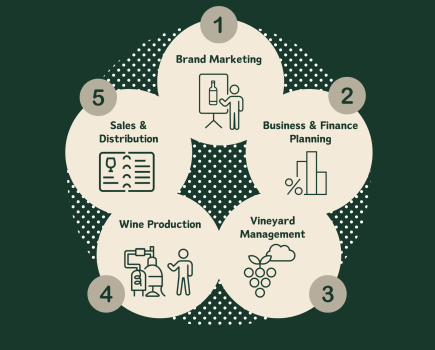It was Monday 23 June 1975, and I was being introduced to the people who would be my workmates for the next twelve months. No doubt the chef (the boss) had told them that they had a new praktikant starting that morning and I feel sure they would have asked ‘What nationality? South African, Italian, USA, Dutch?’ – they had seen a fair few over the years. I am sure when he said ‘English’ there was a general groan along the lines of ‘what do they know about vineyards?’ and of course they were quite right – I knew practically next to nothing. We soon piled into an old green van which took us to and from the different vineyards that made up the 170 ha Schönborn estate which stretched for over 60km from Lorch in the west to Hochheim in the east. That morning we were heading for one of their steepest (and warmest) sites, the Rüdesheimer Roseneck.
After around 30 minutes we arrived at the vineyard and unloaded our meagre equipment, a few very basic steel hoes, and after a quick pause for some water, Angelo, the 5’ nothing Sicilian who was the foreman of the gang, handed me a hoe and said what I assumed to mean ‘follow me’ as he set off up the slope. The slopes here are truly heroic, almost at 45° in places, and there is only one way to work if you are on foot, top to bottom. The work was hard and repetitive – clearing the weeds away from the vines as gravity helped us down the slope – with a quick stop each time we reached the bottom for a drink and a short pause, before trudging back to the top for the next row. The work seemed to go on forever, and boy, was I glad when 11.30 am came around and we could head back to the yard for lunch.
The work amongst the vines followed the seasons as it always has and always will. The year started with pruning in early December and lasted until mid-March. With pruning and tying down finished, there was a chance to attend to the trellising, replacing broken wooden posts, tightening up wires, and generally getting the vineyards ready for the coming season. As the season progressed there were buds to be rubbed off, followed by tender shoots to be tucked in and made secure. In the summer as the shoots lengthened and grapes appeared, there was more tucking in, topping canes and some leaf removal in the better vineyards. As harvest approached, the whole workforce readied themselves for picking and winemaking. Presses were exhumed from their winter quarters, tanks and barrels were cleaned and readied, and picking buckets and grape ‘hods’ were dusted off and stacked in the yard. The years I was in Germany –1975 and 1976 – were both hot years with early harvests and the weather was pretty kind throughout the picking weeks. In fact I only picked grapes for the first morning, wangling a place in the press-house, where I loaded and unloaded one of the Willmes airbag presses, keeping the place as clean and tidy as possible, and generally being useful around the winery – a true cellar rat!
One of the reasons I was keen to work in the Rheingau was its proximity to Geisenheim, arguably the premier wine school in Germany. Whilst its winemaking department was well-known, it was its vine-breeding section for which it was famous. It was the birthplace of Müller-Thurgau, then Germany’s most widely planted variety and also the variety that bulked up most of the Liebfraumilch that was then being made, but the school was also proud of its work on rootstocks, Riesling, and new varieties. The vine-breeding department was headed by Professor Helmut Becker, who enthusiastically welcomed me and soon set my mind at rest when I asked him about studying there. ‘No problem’ he said in his excellent (if American-accented) English ‘just go to the main reception and ask for a gasthörer [observer] ticket’. As simple as that. 50 deutschmarks (about £20) later I was the proud owner of a guest ticket which allowed me to attend any lecture I wanted, use the facilities – library, canteen, gym etc – and take part in events and outings.
Professor Becker was amazing, a real superstar in the world of vine breeding. He would speak to me in almost perfect English, perfect grammatically, but peppered with salty words that my mother would certainly not have approved of. I asked him once “where did you learn this slang?” and he told me the story. Aged 16, he was press-ganged into the German army in the final year of the war, and his father told him “the first time you see an American soldier – surrender.” This he did and was shipped off to a prisoner-of-war camp in Florida where he learnt the finer points of colloquial English by a sergeant-major who basically swore at his charges from dawn to dusk.
Once I had finished my 12 months at Schönborns, I spent as much time as I possibly could, attending classes, sitting in the library, going on trips and visits and reading as much as I could about vineyard establishment. As the long, hot summer of 1976 ended and we returned to England for my sister’s wedding, my father-in-law told me that the 71 ha (175 acre) hop, fruit and pasture farm which adjoined his estate in Tenterden, Kent (today the home of Chapel Down) was on the market, and he intended to buy it.
Anticipating that I might be interested in some of the land he had already had the land surveyed by a soil scientist called Alan Furneaux. Alan, and his father Basil before him, had surveyed almost every fruit farm in Kent and Sussex so he knew what he was talking about. He had written in his report: “It is my understanding that some of this land is to be used to plant vines. I cannot think of a finer site in the whole of the south of England for a vineyard.” With this ringing endorsement, we told my father-in-law that we would love to farm it, and set about deciding what varieties to plant, how much and in which fields.
We liked the look of the farm buildings which we thought would make a good winery, storage sheds and farm shop. With the land no higher than 60m above sea level, free-draining sandy soil and some sheltered south-facing slopes, we had high hopes for our new enterprise.
After all this excitement it was time to go back to Germany where for the next five months, I busied myself in more studying and more visiting vineyards, plus the task of selecting which varieties to plant. By now, Professor Becker and I knew each other well, and he was most generous with his time. He had already been in contact with Kenneth McAlpine and together with Professor Kiefer, head of Geisenheim’s viticulture school, had visited Lamberhurst and been involved with their site and variety selection. I thought the best way of going about this was to write down a list of all the possible varieties that I had been collecting data on and then discuss them with Professor Becker. I showed him the list one afternoon after a lecture, and he said: “I’m busy now, come back on Thursday” which I duly did.
“Lets go down to the cellar,” he said and we descended two floors down to the lower cellar where tastings always took place. There, stretched out on the long oak table, was a bottle of wine from every variety on my list, about 35 in total! We then spent the next two hours tasting every one, me making notes as we went, and Professor Becker making useful comments.
Of course, then as now, selecting varieties is fraught with danger. Do you plant the tried and tested varieties that everyone else is using, or take a chance and choose something that nobody else is using? Of course in those days, there were three varieties that almost all English vineyards were growing: Müller-Thurgau, Seyval blanc and Reichensteiner. They had to be in the mix. I chose a Geisenheim special called Gutenborner which only one other grower in GB had planted (Carr Taylor). I tasted and liked several other varieties and decided to plant a ‘trial vineyard’ with 25 vines of the other ‘major’ varieties: Schönburger, Bacchus, Ortega, Huxel, Madeleine x Angevine and Kerner – plus another 10-15 varieties in smaller numbers. With the vines chosen and ordered, we were well on our way to planting what would become Tenterden Vineyards in April 1977.




